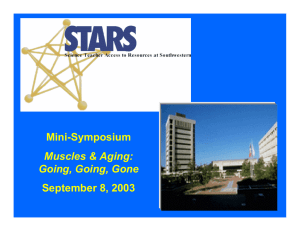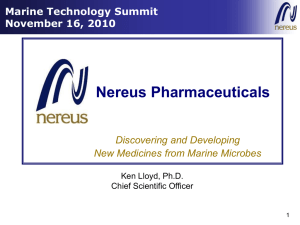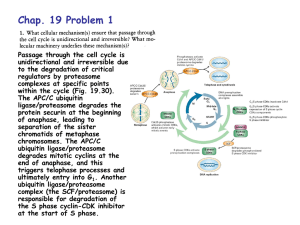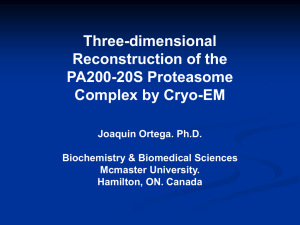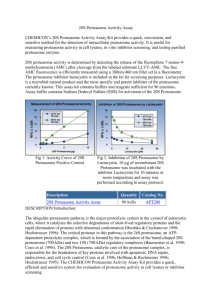Q and A Current Biology
advertisement
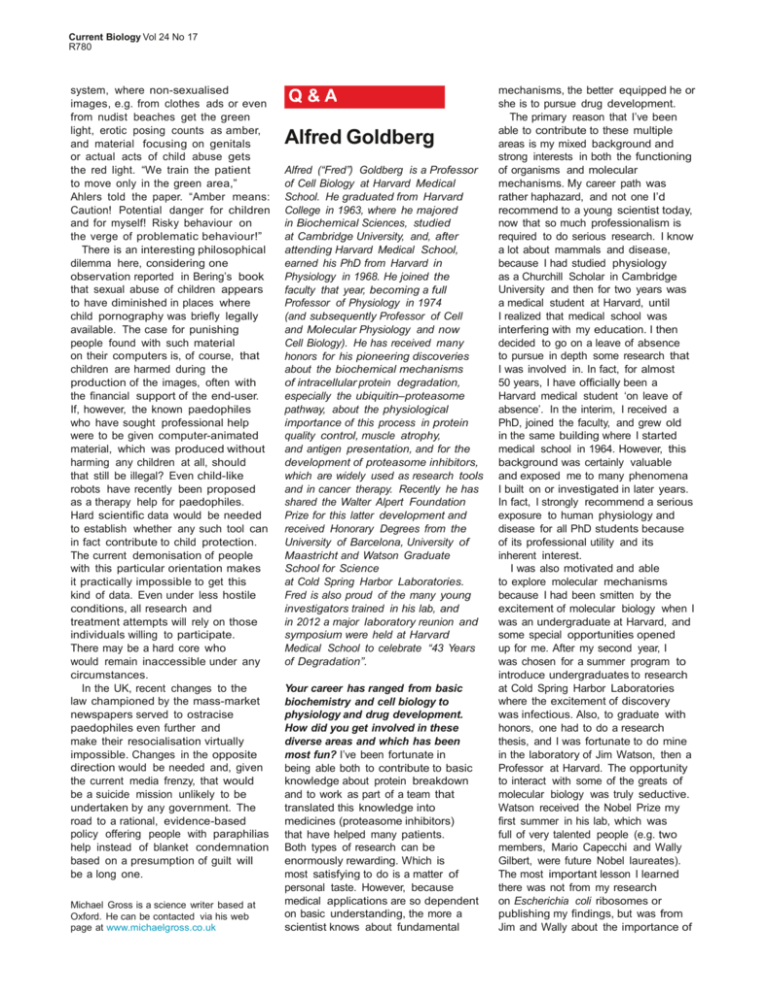
Current Biology Vol 24 No 17 R780 system, where non-sexualised images, e.g. from clothes ads or even from nudist beaches get the green light, erotic posing counts as amber, and material focusing on genitals or actual acts of child abuse gets the red light. “We train the patient to move only in the green area,” Ahlers told the paper. “Amber means: Caution! Potential danger for children and for myself! Risky behaviour on the verge of problematic behaviour!” There is an interesting philosophical dilemma here, considering one observation reported in Bering’s book that sexual abuse of children appears to have diminished in places where child pornography was briefly legally available. The case for punishing people found with such material on their computers is, of course, that children are harmed during the production of the images, often with the financial support of the end-user. If, however, the known paedophiles who have sought professional help were to be given computer-animated material, which was produced without harming any children at all, should that still be illegal? Even child-like robots have recently been proposed as a therapy help for paedophiles. Hard scientific data would be needed to establish whether any such tool can in fact contribute to child protection. The current demonisation of people with this particular orientation makes it practically impossible to get this kind of data. Even under less hostile conditions, all research and treatment attempts will rely on those individuals willing to participate. There may be a hard core who would remain inaccessible under any circumstances. In the UK, recent changes to the law championed by the mass-market newspapers served to ostracise paedophiles even further and make their resocialisation virtually impossible. Changes in the opposite direction would be needed and, given the current media frenzy, that would be a suicide mission unlikely to be undertaken by any government. The road to a rational, evidence-based policy offering people with paraphilias help instead of blanket condemnation based on a presumption of guilt will be a long one. Michael Gross is a science writer based at Oxford. He can be contacted via his web page at www.michaelgross.co.uk Q&A Alfred Goldberg Alfred (“Fred”) Goldberg is a Professor of Cell Biology at Harvard Medical School. He graduated from Harvard College in 1963, where he majored in Biochemical Sciences, studied at Cambridge University, and, after attending Harvard Medical School, earned his PhD from Harvard in Physiology in 1968. He joined the faculty that year, becoming a full Professor of Physiology in 1974 (and subsequently Professor of Cell and Molecular Physiology and now Cell Biology). He has received many honors for his pioneering discoveries about the biochemical mechanisms of intracellular protein degradation, especially the ubiquitin–proteasome pathway, about the physiological importance of this process in protein quality control, muscle atrophy, and antigen presentation, and for the development of proteasome inhibitors, which are widely used as research tools and in cancer therapy. Recently he has shared the Walter Alpert Foundation Prize for this latter development and received Honorary Degrees from the University of Barcelona, University of Maastricht and Watson Graduate School for Science at Cold Spring Harbor Laboratories. Fred is also proud of the many young investigators trained in his lab, and in 2012 a major laboratory reunion and symposium were held at Harvard Medical School to celebrate “43 Years of Degradation”. Your career has ranged from basic biochemistry and cell biology to physiology and drug development. How did you get involved in these diverse areas and which has been most fun? I’ve been fortunate in being able both to contribute to basic knowledge about protein breakdown and to work as part of a team that translated this knowledge into medicines (proteasome inhibitors) that have helped many patients. Both types of research can be enormously rewarding. Which is most satisfying to do is a matter of personal taste. However, because medical applications are so dependent on basic understanding, the more a scientist knows about fundamental mechanisms, the better equipped he or she is to pursue drug development. The primary reason that I’ve been able to contribute to these multiple areas is my mixed background and strong interests in both the functioning of organisms and molecular mechanisms. My career path was rather haphazard, and not one I’d recommend to a young scientist today, now that so much professionalism is required to do serious research. I know a lot about mammals and disease, because I had studied physiology as a Churchill Scholar in Cambridge University and then for two years was a medical student at Harvard, until I realized that medical school was interfering with my education. I then decided to go on a leave of absence to pursue in depth some research that I was involved in. In fact, for almost 50 years, I have officially been a Harvard medical student ‘on leave of absence’. In the interim, I received a PhD, joined the faculty, and grew old in the same building where I started medical school in 1964. However, this background was certainly valuable and exposed me to many phenomena I built on or investigated in later years. In fact, I strongly recommend a serious exposure to human physiology and disease for all PhD students because of its professional utility and its inherent interest. I was also motivated and able to explore molecular mechanisms because I had been smitten by the excitement of molecular biology when I was an undergraduate at Harvard, and some special opportunities opened up for me. After my second year, I was chosen for a summer program to introduce undergraduates to research at Cold Spring Harbor Laboratories where the excitement of discovery was infectious. Also, to graduate with honors, one had to do a research thesis, and I was fortunate to do mine in the laboratory of Jim Watson, then a Professor at Harvard. The opportunity to interact with some of the greats of molecular biology was truly seductive. Watson received the Nobel Prize my first summer in his lab, which was full of very talented people (e.g. two members, Mario Capecchi and Wally Gilbert, were future Nobel laureates). The most important lesson I learned there was not from my research on Escherichia coli ribosomes or publishing my findings, but was from Jim and Wally about the importance of Magazine R781 choosing a really fundamental problem to work on and to have the courage to pursue it. There must be real satisfaction in looking back over 45 years and seeing how knowledge about protein degradation developed so dramatically. It’s been wonderful to be able to play a major role in this field’s development — from a topic that few people thought worthy of study to one which is central to understanding many aspects of cell function. When I started my lab in 1969, almost nothing was known about why cells degraded proteins, or how this process occurred. I therefore had the freedom to investigate all these basic questions, which led unexpectedly to new types of enzymes (ATP-dependent proteases and proteasomes). Because few were interested in the field, we did not worry about labs competing with us. That luxury has long disappeared. Now we suffer from the opposite challenge of keeping up with the explosion of new discoveries. It is hard now to appreciate how much freedom this degree of ignorance provided. Because my findings as a student had convinced me that protein breakdown was a fundamentally important feature of cells, in establishing my own lab I decided to focus on this area. I continued to study the regulation of protein turnover in muscle, because I had found that atrophy occurred primarily through an acceleration of proteolysis, and this process was of medical interest. However, I especially wanted to learn why cells degraded proteins at all, since this process seemed highly wasteful. Therefore, I chose to pursue such questions in E. coli, because they provided enormous advantages for genetic and biochemical studies. (Also, I enjoyed both growing bacteria and operating on rodents.) Studying protein degradation in E. coli sounds like a strange choice, especially since you were an Assistant Professor of mammalian physiology. Certainly, and even I realized that E. coli was not a mammal! Thankfully, my colleagues viewed physiology in its broadest sense and, though my grants concerned muscle, the NIH recognized that, in using E. coli, we were asking questions about the functioning of all cells. Nowadays, few departments or granting agencies are so enlightened. However, it was also considered a foolish choice by my biochemistry friends because Jacques Monod, one of my scientific heroes, had published that protein breakdown did not occur in growing bacteria and argued that the reports that proteins in mammalian cells were continually turning over were artifactual. However, we and others demonstrated in the early 70s that bacteria, during exponential growth, degraded rapidly misfolded or mutated proteins, as we also showed in rabbit reticulocytes and even mitochondria. In fact, we were the first group to emphasize the importance of protein degradation in cellular quality control and homeostasis. At the time, this fundamental role for protein turnover was not widely recognized. Probably my most influential early publication was a lengthy two-part review in the Annual Review of Biochemistry (1974). In those pre-internet days, preparing reviews was an act of martyrdom, requiring weeks in libraries, but was crucial in providing guides to the literature. However, my goal was different — to influence thinking and spread the gospel that a protein’s stability in cells was determined by its structure, i.e. its primary sequence, proper folding, and ligand binding. The major message in the second part of the review (published in 1976) was also noteworthy — that protein breakdown was so selective that it could not be due to lysosomes, as believed. So there had to exist a nonlysosomal process that required ATP and selectively removed abnormal and regulatory proteins, as we showed the subsequent year in reticulocytes and bacteria. Since then, the elucidation of these systems and their unexpectedly complex mechanisms has kept a large number of investigators quite busy. But isn’t protein breakdown a very different process in bacteria and eukaryotes? Yes, but we didn’t know that in 1969. In choosing to study E. coli, I was building on the widespread belief at the time, that if we understood E. coli, we would understand the elephant. This was certainly naive in the case of protein breakdown. Although protein breakdown serves similar functions in eukaryotes as in E. coli, these bacterial cells lack ubiquitin and proteasomes. In fact, our focus on bacteria probably explains our failure to discover the role of ubiquitin in our reticulocyte system, which was the seminal contribution of Hershko, Ciechanover and Rose (for which they received the Nobel prize in 2005). So, was studying bacteria a mistake or a distraction? Definitely not. These cells allowed us to clarify the physiological roles of protein breakdown and in subsequent mechanistic studies, we discovered ATP-hydrolyzing proteases (Lon, Clp, HslUV). Also knowledge gained about these novel multimeric enzymes enabled us and Rechsteiner’s group to demonstrate the eukaryotic 26S proteasome, which catalyzes the ATP-dependent degradation of ubiquitinated proteins and shares mechanistic features with these bacterial enzymes. In addition, to our surprise, these basic discoveries in E. coli proved to be of practical importance. With the development of the recombinant DNA industry, knowledge about protein breakdown in E. coli became of considerable industrial relevance. A major unanticipated barrier to the expression of many proteins of medical interest (e.g. insulin) was that the E. coli rapidly degraded the foreign protein. Thus, knowledge we had gained about the enzymes that digest misfolded proteins, about mutants defective in this process, or about the tendency of misfolded proteins to form easily-isolated intracellular inclusions influenced the development of industrial procedures. Suddenly, the importance of protein degradation in bacteria became widely appreciated, and our phones started ringing frequently as company scientists sought advice. This is a great example of the unpredictable benefits of basic research. How did you first become interested in this neglected area? This interest in protein degradation arose accidentally through experiments I did as a student on muscle atrophy. In my anatomy course, we were supposed to know if a specific nerve was cut, what muscles became inactive and therefore atrophied. I started wondering how an inactive muscle actually decreased in protein content. Because the literature provided no insights, I initiated experiments which I assumed would indicate how inactivity reduced protein synthesis. Surprisingly, I found that synthesis in the atrophying Current Biology Vol 24 No 17 R782 muscles did not clearly decrease, and therefore I began thinking about protein breakdown. Eventually by using an abundance of rats and radioactive amino acids (which in those days students could use without restrictions), I showed that disuse and fasting decreased muscle size mainly by accelerating protein breakdown. The realization that organ size was determined by an unknown process was exciting and more interesting to pursue than completing medical school. Because I knew the advantages of bacteria and reticulocytes for understanding protein synthesis, the path forward seemed clear. In truth, these career decisions were more difficult than this account implies. My ability to follow my own curiosity was only possible through the encouragement and support of certain great figures on the Harvard faculty — especially my extremely generous mentor Moe Goodman, but also David Hubel, Torsten Wiesel, Gene Kennedy, Arthur Pardee, Bernie Davis and Alex Rich (MIT), who were both thoughtful sources of advice and role models. These interests seem far removed from starting a biotech company and developing drugs against blood cancers. If one works on fundamental cellular processes, one can not always predict where it may lead you. Although I’m supposed to be rather knowledgeable about physiology and disease, in developing proteasome inhibitors we never foresaw that they would be used to treat multiple myeloma, the cancer of plasma cells. Our drug-development efforts, which I described elsewhere (J. Cell Biol. (2012) 199, 584–588), emerged from our discovery in the late 1980s that the ubiquitin–proteasome pathway not only eliminates misfolded and regulatory proteins, but also catalyzes the slower breakdown of most cellular proteins. Specifically, we found that this pathway was activated during muscle wasting (e.g. in cancer cachexia) through a specific transcriptional program, and its activation is the primary cause of the atrophy. This recognition led to my original rationale for wanting to make proteasome inhibitors — the naive hope that, by partially inhibiting proteasome function, we could reduce this debilitating excessive proteolysis. Also, by 1992, we knew enough about the proteasome’s mechanism to see a rational approach for inhibitor synthesis. I decided to found a biotech company because there was no mechanism within the university to bring together a team with the multiple types of expertise needed to develop a drug. Also, in advising biotech companies, I had found that working with a talented team on a common goal could be stimulating and fun. I was able to convince several colleagues and a venture capitalist to help found a small company with the initial goal of combatting muscle wasting, but I also had a hidden agenda. I realized that proteasome inhibitors that were active in cells would be very valuable tools to clarify the physiological functions of the proteasome. In fact, our early inhibitor, MG 132, has now been used in thousands of publications and enabled the elucidation of many key cellular processes. Amongst the important functions discovered was the proteasome’s role in activating the transcription factor NFκB. Because of the critical role of NFκB in inflammation and growth of many cancers, the company changed its focus. Chemists in the company soon generated the peptide boronate, bortezomib/Velcade, which was active in several disease models and eventually entered trials against all cancers. Dramatic responses were seen in patients with multiple myeloma. Consequently, this agent gained rapid FDA approval in 2004 and has already helped prolong the lives of several hundred thousand patients. The special sensitivity of myeloma cells to proteasome inhibition was not foreseen and became clear only in clinical trials. This unique sensitivity is a result of these cells being exceptionally active in degrading misfolded proteins (abnormal immunoglobulins) and highly dependent on NFκB. Bortezomib’s development is further evidence that medical and scientific advances go hand in hand, and that the benefits of basic discoveries are often not predictable. Unfortunately, granting agencies in their zeal to assist patients, often forget these truths. You have been doing biomedical research for 50 years now. How different is it to do science now compared with back then? Enormously. Back in the 70s and 80s, we spent a lot less time preparing research grants, worrying about job prospects, or arguing with referees. Nevertheless, people worked very hard. Also, because so little was known, even students were at the frontiers of knowledge. Unfortunately, the enormous amount of information that has accumulated since then seems to intimidate young people from asking fundamental questions or speculating about new areas. Perhaps because I grew up in those Dark Ages, I’ve never been afraid to ask naïve questions or delve into new areas. In fact, by bringing an outsider’s perspective, I have been able to contribute to areas where I lacked professional credentials (e.g. antigen presentation). Consequently, I believe some naiveté together with curiosity (and chutzpah) are valuable assets for a scientist. Certainly, doing research today is more fast-paced and technically easier. Before the 1990s, getting answers to biochemical questions was much harder because virtually all the methods we now use were not available or even imaginable. If someone had told me in 1985 that we could test our speculations by repressing a specific mRNA in cells or by downloading in seconds to a pocket telephone the structure of a protein from some megalibrary in the sky, I would have thought it an amusing science-fiction plot. These tools are enormously empowering and have allowed us to replace ignorance with knowledge. Unfortunately, younger investigators take these advances for granted and often miss the great beauty of the achievements that we continually build on. Few papers cite work more than a few years old, and while it’s appropriate that scientists focus on what’s new and exciting, in doing so, we often forget where ideas come from and lose a sense of continuity and our work’s larger context. You’re starting to sound geriatric. Soon you’ll be reminiscing in your rocking chair about the Good Old Days… perhaps even voting Republican? I certainly hope not! I’m still running a very active lab and am still excited by new findings. This continued stimulation exceeds that of anything else I can imagine doing. Otherwise, I would have retired years ago and spent my time writing pieces like this one. Department of Cell Biology, Harvard Medical School, 240 Longwood Avenue, Boston, MA 02115-5730, USA. E-mail: alfred_goldberg@hms.harvard.edu


